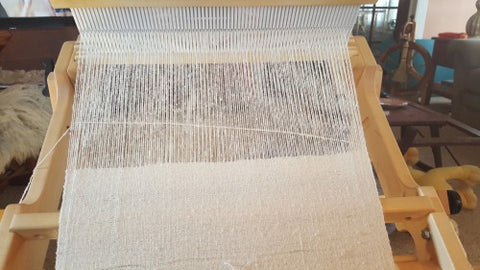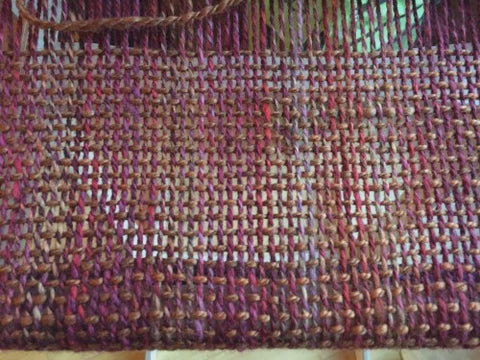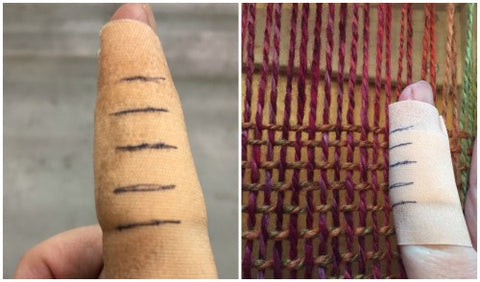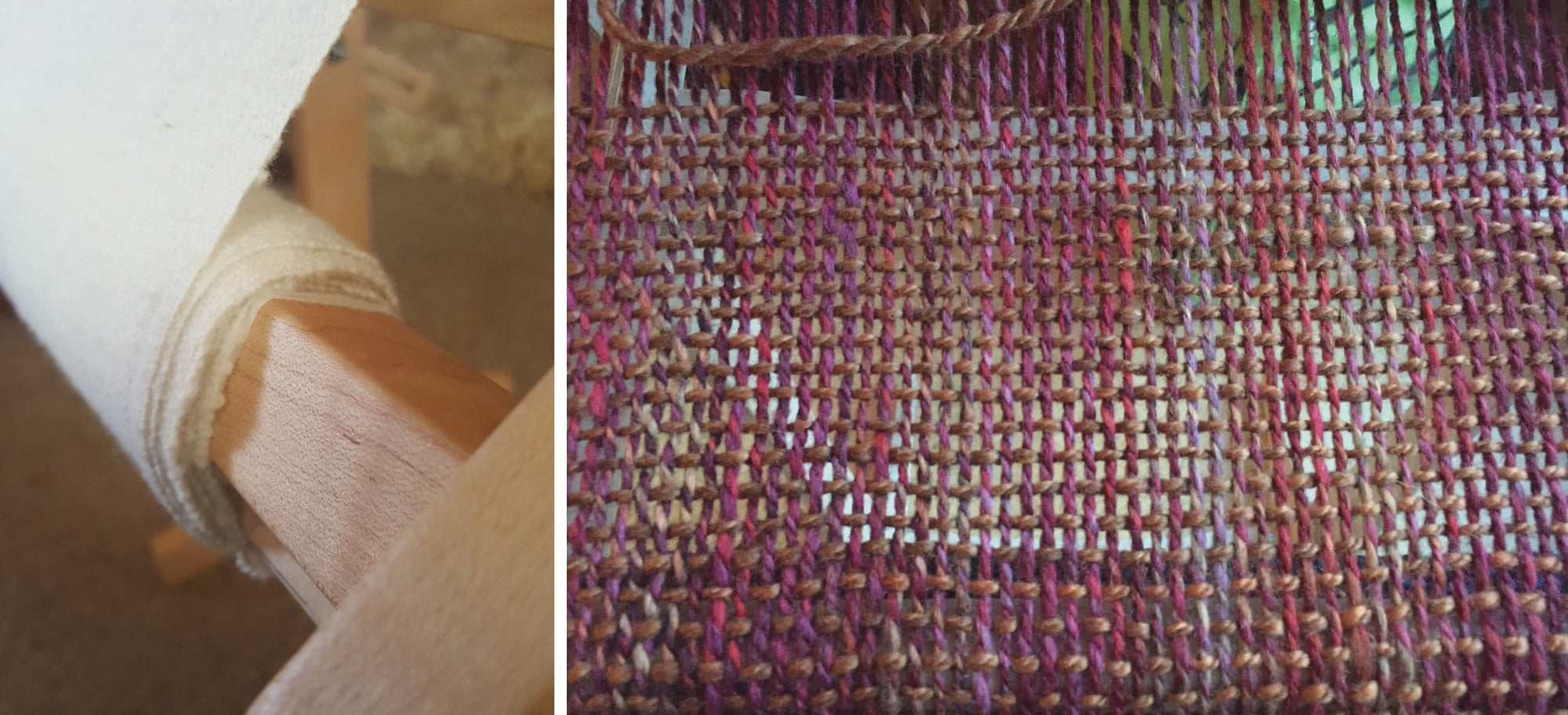
Beth Smith and Jillian Moreno live about 30 minutes from each other and spend a lot of spinning time together, trading ideas and cheering each other on. Recently, the two have found weaving sneaking into their thoughts more and more. “Wouldn’t it be fun,” they said, “to do a project where we spin our yarn and weave it and see what happens?” “Yes!” they said, “that sounds like an awesome plan.” We thought so, too. Through the end of the year, they will post on the Schacht Spindle blog, telling you about their journey weaving with handspun on a rigid heddle loom.
Beth
I’m deep in the weaving of the yardage. Deep. I’m only about 1/3 of the way through, but the fabric is beautiful. Beautiful enough that I am encouraged to continue on. I am in no way saying that everybody will want to weave 6 yards of white fabric. If that sounds like too much for you, please add color. But I have a long and delightful relationship with white.
I’ve learned a lot, too.
First, I’ve learned that with a sticky yarn, tighter tension is better. This yarn is sticky because it is woolen spun, so there are lots of little bits that stick out. That means when the sheds are changing, the warp yarns get stuck on each other. Tight tension allows the threads to move past each other more easily.
You might be saying, “But Beth, you talked in the last post about how the threads have lower twist in the singles and the ply! How can you tighten the tension so much?” Well, let me tell you. You can. Think about a piece of paper. You can rip one piece very easily. If, however, you take a stack of 200 pages you can’t rip it. Works the same way with yarn. The tension is distributed over the whole warp width and so even though I can easily break one thread with my hands, I can tighten the tension with no breakage.
Second, I learned the benefit of advancing the warp more often. The main reason for this is that on the rigid heddle loom, one set of threads stays stationary and one is moved up and down. The ones moving up and down are being stretched. As you weave more and more and don’t advance, those threads are getting stretched even more because a shorter length of yarn has to go into the up and down shed. To avoid stretching them excessively I advance every 2 inches or so.
Third, the Schacht Flip is superior to other rigid heddles with the double heddle option. Because the second heddle spot is built in, everything is in the proper position when you change sheds. Because the rear heddle sits a bit higher than the front heddle, everything is in line. With another brand that I used, the open shed isn’t as clean in front of the reed as it is with the Schacht. Any messiness is behind, as you can see from the photo.

When I’m home, I just make sure I do some weaving every day. It takes me about an hour to weave 6 inches, so I need to keep at it.
One more tip: Make sure to give your yarn a bit of an angle with each throw of the shuttle. The weft yarn will be longer than the warp width when you go to beat it in, but because of the up-and-down movement around each warp thread, you need that extra length.

And just so you know…I’m doing an even weave for this fabric. I have 20 ends per inch and so I am matching that with 20 picks per inch. What I’ve decided is that I would want to try this fabric again with the warp sett even closer and see what would happen if I weave a warp faced fabric. I have a tendency to start asking questions during a project that lead to even more experiments. I’ll keep you updated with the results.
Jillian
Finally it’s time to weave! Well, after I get the loom warped.
I’m really glad I did a test weave before I tackled this main project. I learned quite a bit, just getting something on and off the loom without being worried about the outcome.
I wound all of my yarn into cakes before warping, I knew I didn’t want to warp from yarn on a swift. It was too tangly when I tried that with my scarf.
While I wound my yarn I remeasured the wpi on all three yarns and got 9 pretty consistently, a little big for a 8 epi sett. As I wound, I pondered my wrap-to-be, I really wanted it drapey and I read on a few weaving blogs that for plain weave, your sett should be ½ (ish) of wpi, so I decided to change my sett from 8 epi to 5 epi.
I know, I live on the wild side.

I redid my warp and weft math. I knew I had enough, that my yarn totals would be less going with a smaller sett, but I wanted to see it in black and white. My new totals are 163 yards for warp (down from 261) and 140 yards for weft (down from 224). I kept everything else the same: finished size of 12”x 60”, 12” for loom waste, 10% for take up and 10% for draw in; I just changed the sett from 8 to 5.

That my wrap will use less yarn made me happier from a color standpoint. I have three yarns, one primarily red, one primarily orange and one dark purple. Using less yardage overall means I won't have to dip so heavily into the dark purple yarn that will dampen the rest of the colors.

I used the direct method of warping, the same as my practice weaving. I did remember to turn my loom the right way this time! I like warping this way; it’s quick and easy. It does take up space, but I took the dining room table hostage for an evening. Threading 5 epi is fantastically quick and I ended up making my wrap a little wider than I originally planned; I threaded 14” instead of 12”. This is exactly why I need to think in terms of "ish" -- I like to change my plans on the go.

When I started weaving I remembered what I learned about placement of weft yarn and selvedges. For me, my selvedges stay more even if I place my yarn in an arc rather than a diagonal. I’m not sure why, but the difference in my practice piece was dramatic so I made sure to do it this way.

I am really happy that I can cart my Cricket around from room to room; I worked at the dining room table, on my lap and using the stand. I have extra love for weaving on the stand because the height of the loom is close to the height of the orifice on my Matchless, so my favorite spinning chair is perfect to use for weaving too.

Ready for my hot tip and my lemonade-from-lemons moment? I realized that weaving 5 weft threads to the inch was trickier than I thought because of the need for more precise spacing and the need to pay attention. However, I cut my index finger to the bone this week in the kitchen (don’t ask, it was monumentally stupid) - an injury that required 7 stitches and a fat band aid. To help myself maintain my weft spacing, I marked 5 evenly spaced lines over an inch on my band aid and used it to check my warp threads. Perfectly lazy/genius, my favorite type of trick!


